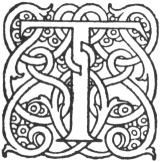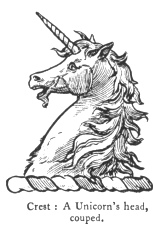
Sacred Texts Legendary Creatures Symbolism Index Previous Next
Buy this Book at Amazon.com


Fictitious and Symbolic Creatures in Art, by John Vinycomb, [1909], at sacred-texts.com
Unicorn salient. *
"The lion and the unicorn fighting for the crown."
Old Nursery Rhyme.
 |
met with as a coat-of-arms. As a crest or supporter it is of more frequent occurrence. A unicorn's head is a favourite bearing, either erased, or couped, at the shoulder, and always represented in profile.
The unicorn was a famous device all over Europe, and symbolised
 |
James III. of Scotland had it figured on coins which were thence called "unicorns." James V. first used it with the national arms as supporters. Although the silver unicorn came into England with James I., Queen Jane Seymour had already adopted it.
"Unicorn" was the pursuivant of Lord Lyon King-at-Arms, the Royal Scottish Herald.
As a supporter to the Royal arms it is thus blazoned: A unicorn argent, armed, unguled, crined and gorged or, with a royal coronet (i.e., composed of crosses patée and fleurs-de -lis), having a chain
affixed thereto, and reflexed over his back of the last. The term "armed" has reference to his horn, "unguled" to his hoofs, and "crined" to his flowing mane. "Gorged" implies that the coronet encircles his "gorge" or throat. The term "or" (that is, the metal gold or the tincture of it) being only mentioned after the several parts implies that they are all alike to be gold. "Of the last" means of the last colour mentioned.
In "The History of Caricature and Grotesque in Literature and Art," by Thomas Wright, M.A., F.S.A. (p. 8), appears a curious illustration from an Egyptian papyrus of the Roman period, in the British Museum. It represents a lion and a unicorn playing a game resembling draughts, perhaps the earliest instance of the two animals depicted in conjunction. As the author says: "The lion has evidently gained the victory and is fingering the money; his bold air of swaggering superiority as well as the look of surprise and disappointment of his vanquished opponent are by no means ill-pictured."
The animosity which existed between the lion and unicorn is referred to by Spenser, and is allegorical of the animosity which once existed between England and Scotland:
127:* But for an oversight in the drawing, the unicorn should have been represented with the divided hoofs of a stag.